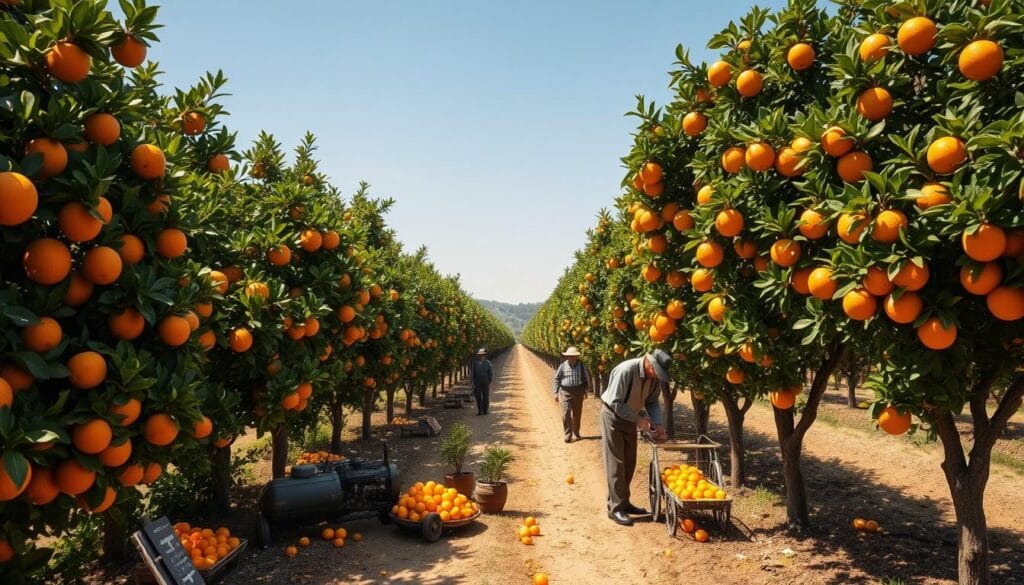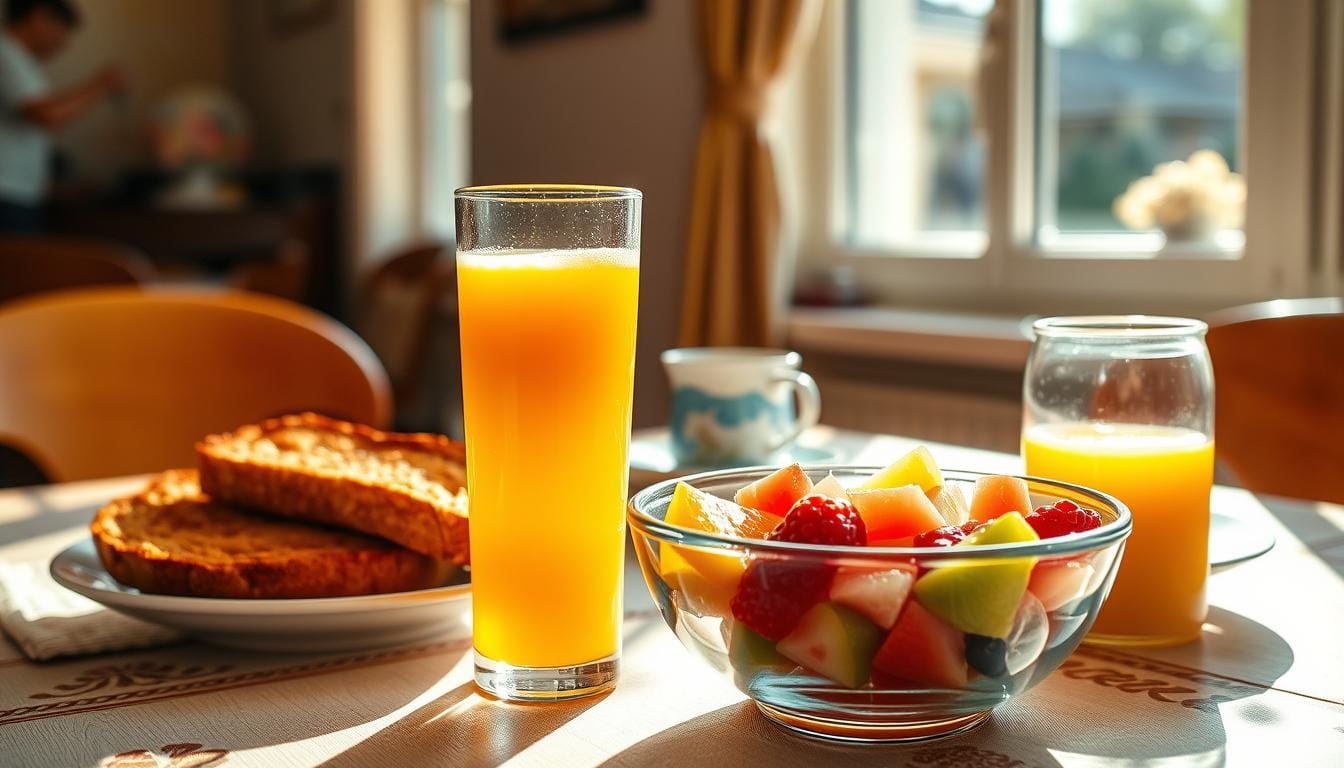Ever thought about why do Americans drink orange juice in the morning? The tale behind this tradition is quite interesting.
The history of breakfast isn’t simple. In the early 1900s, a clever marketing move helped start the morning orange juice tradition. Fruit growers in Florida and California had too many oranges and needed a way to use them.
In 1916, a smart ad campaign was born: ‘Drink an orange.’ This slogan changed how Americans enjoyed oranges, moving from eating them whole to drinking juice.
The big moment came during the 1918 flu pandemic. Marketers saw a chance to promote orange juice as a beneficial drink. They worked hard to make it a part of the American breakfast.
By the 1950s, orange juice was a common choice in American homes. The American Can Company even said it saved housewives a lot of time. This made it a popular breakfast choice.
Your morning orange juice is more than a drink. It’s a result of smart marketing, too many oranges, and changing eating habits in America.
The Birth of Morning Orange Juice: A Marketing Success Story
In the early 1900s, California orange growers faced a big challenge. They had more oranges than people wanted to eat. This problem would change American breakfast forever.

Then, a smart advertising plan changed everything. It made Americans see oranges and breakfast in a new way.
The California Fruit Growers Exchange Problem
In 1907, orange producers hit a snag:
- They had too many oranges
- People only ate half an orange at a time
- They needed to get people to want more oranges
Albert Lasker’s Revolutionary Campaign
Albert Lasker from Lord & Thomas came up with a plan. He was key in making American breakfast what it is today. His idea changed how people ate oranges.
“Drink an Orange” became the revolutionary campaign slogan that shifted consumer behavior.
Creating Consumer Demand
Lasker’s plan was simple yet worked:
| Marketing Strategy | Impact |
|---|---|
| Juice Extractors | 3 million units sold at 10 cents each |
| Consumption Increase | 400% rise in orange juice consumption |
| Average Serving Size | Increased from 0.5 to 2.5 oranges |
By the early 1920s, orange juice was a key part of breakfast. It went from a rare treat to a daily habit. This success not only helped orange growers but also changed eating habits for many years.
The Early 1900s Orange Production Boom

In the early 1900s, the orange industry saw a big change. This change would change how Americans started their day. Oranges were once a luxury, eaten only on special days.
California and Florida became the main places for growing oranges. But, they didn’t produce as much as they would later. Farmers had trouble selling their oranges because of pricing and distribution issues.
“An orange a day keeps the doctor away” – Sunkist Marketing Slogan
Important things happened during this time:
- Limited national distribution of oranges
- Seasonal consumption patterns
- Fluctuating market prices
- Lack of unified marketing strategies
In 1909, growers faced a big problem: too many oranges. This led to new ideas in marketing and eating oranges.
The completion of the transcontinental railroad in 1869 helped oranges reach more places. This made it easier for oranges to get to markets all over the U.S.
By the late 1900s, the stage was set for a big change. This change would lead to the orange juice boom that followed.
Why do Americans drink orange juice in the morning?
In the early 20th century, America’s morning breakfast changed a lot. Orange juice wasn’t as popular back then as it is now. It became a morning favorite thanks to smart marketing.
The Strategic Timing Decision
Marketers wanted to make orange juice a special morning drink. The California Fruit Growers Exchange came up with a plan. They made orange juice a morning drink, different from lemonade, which was for the afternoon.
- In 1930, per capita consumption of canned orange juice was minimal
- By 2003, 21% of Americans consumed orange juice daily
- Marketing campaigns in the 1920s significantly boosted orange consumption
The Breakfast Table Revolution
The American breakfast table changed a lot. Orange juice became more than a drink. It was a sign of a big change in culture. Ads made it seem like a beneficial, refreshing way to start the day.
| Year | Orange Consumption | Marketing Strategy |
|---|---|---|
| 1915 | Low | “Drink an Orange” campaign |
| 1920s | Increasing | Vitamin C promotion |
| 1940s | Significant growth | Frozen concentrate introduction |
Cultural Impact on American Mornings
By making orange juice a morning must, marketers changed American life. It became a sign of a nutritious, energetic start. What was once rare became a common part of breakfast in the U.S.
“Orange juice isn’t just a drink, it’s a morning ritual” – Beverage Marketing Experts
The Evolution from Fresh Oranges to Commercial Juice
The journey of orange juice from fresh fruit to commercial product shows how American breakfast habits changed. The invention of eating breakfast as we know it today was linked to food processing technology. By the 1930s, canned orange juice was available but hardly anyone consumed it, with only 0.01 pounds per person each year.
Industrial changes greatly impacted orange juice production. Florida’s groves, which grew a quarter of the world’s oranges, were at the heart of this change. The old way of squeezing oranges was replaced by more complex methods.
“A can of orange juice was boiled to high viscosity in a vacuum, separated into several parts, reassembled, flavored, and frozen solid.”
- Post-World War II food processing technologies emerged
- Flash-freezing techniques revolutionized juice production
- Concentrate became the new standard for orange juice
By the time commercial production reached its peak, orange juice had changed a lot. Freshly squeezed juice was becoming a memory, replaced by industrial methods that focused on efficiency and scale.
| Production Era | Key Characteristics |
|---|---|
| Pre-1930s | Fresh squeeze, limited distribution |
| 1940-1960 | Concentrate development, mass production |
| 1960-Present | Industrial processing, global distribution |
Today, big companies like PepsiCo and Coca-Cola make about 60% of orange juice in the United States. This shows how far the industry has come from its early days.
World War II’s Impact on Orange Juice Production
World War II changed more than just the battlefield. It also changed American breakfast habits, like orange juice production. The U.S. military wanted nutritious, easy-to-carry drinks. This led to big changes in how orange juice was made.
Military Rations Development
During the war, Florida’s citrus industry was key for military food. Growers planted 100,000 more acres to meet the military’s needs. The government worked hard to:
- Make juice that could be kept fresh for a long time
- Create drinks full of nutrients for soldiers
- Build new places to process juice
Frozen Concentrate Innovation
The war led to big steps in orange juice technology. Citrus World, a new plant, was a key place for these changes. Interestingly, 10,000 German prisoners of war helped build it. This shows how the war brought people together.
Post-War Consumer Adoption
After the war, these changes made people love orange juice more. Frozen concentrate made it easier to get and enjoy. Today, Florida’s citrus industry is worth $8 billion, thanks to these wartime changes.
“The war didn’t just change battlefields—it reinvented how Americans thought about breakfast.”
The 1920s Advertising Revolution
The 1920s were a big change for breakfast in America. This decade brought new marketing ideas that changed how people thought about breakfast.
Vitamin discoveries were key in the orange juice marketing push. Advertisers used science to show how oranges were good for you. They targeted people with messages about wellness benefits.
- Vitamin research became a key marketing tool
- Scientific claims drove consumer interest
- Orange consumption skyrocketed through strategic campaigns
“Drink your orange juice – it’s packed with vitamins!” became a popular wellness mantra during this era.
The California Fruit Growers Exchange ran big ad campaigns. These changed how people saw breakfast. Did people eat breakfast in the 1800s the same way? No, the 1920s brought a new focus on wellness and convenience.
| Marketing Strategy | Impact |
|---|---|
| Scientific Claims | Increased Consumer Trust |
| Vitamin Promotion | Drove Orange Juice Popularity |
| Breakfast Reinvention | Changed Dietary Habits |
Advertisers linked science to daily life, making orange juice a key morning drink. They used new nutritional knowledge to change breakfast habits in America.
The Transformation of American Breakfast Habits
The early 20th century saw a big change in how Americans started their day. What did people eat for breakfast in 1910? It shows a journey of food changes due to new lifestyles and tech.
Busy lives and new tech changed breakfast habits. The rise of easy-to-make foods was key. It let families cook meals faster and easier.
Changing Consumer Preferences
How people ate breakfast changed a lot during this time. Family breakfasts changed a lot:
- In the 1920s, about 60% of middle and upper-class families ate breakfast together
- Only 30% of working-class families shared morning meals
- Nearly 40% of working-class children skipped breakfast due to time constraints
Rise of Convenience Foods
New packaged foods changed how we start our day. Key changes included:
- Packaged cereals became widely available around 1920
- Electric refrigerators improved food storage (introduced in 1925)
- Frozen foods expanded quick breakfast options
“Convenience became the new currency of morning meals” – Culinary Historians
| Year | Breakfast Innovation | Impact |
|---|---|---|
| 1920 | Packaged Cereals | Reduced preparation time |
| 1925 | Electric Refrigerators | Improved food preservation |
| 1930 | Frozen Foods | Expanded breakfast options |
By using these new ideas, Americans made their mornings faster and easier. They kept the taste and nutrition good.
From Fresh Squeeze to Mass Production
The journey of orange juice from fresh squeeze to mass production changed American breakfast habits. Who invented American breakfast? The answer is in the new technologies that changed juice making. These advancements made commercial orange juice more appealing and easy to get for people all over the country.
Flavor innovation was key in this change. Juice companies created “flavor packs” – special mixtures that brought back the taste of fresh-squeezed juice. These new methods let makers make tasty orange juice all year round.
“The secret to great orange juice isn’t just in the fruit, but in the technology behind its production.” – Juice Industry Expert
- Flavor pack technology enables year-round consistent taste
- Mass production techniques reduced orange juice costs
- Innovative processing maintained nutritional value
The market statistics show the effect of these innovations:
| Orange Juice Production Metric | Annual Data |
|---|---|
| Total U.S. Consumption | 5.7 Million Gallons |
| Fresh-Squeezed Percentage | 25% |
| Mass-Produced Percentage | 75% |
| Market Growth Rate | 3% CAGR |
These technological breakthroughs made orange juice more convenient and changed the American breakfast experience. They provided a consistent, tasty, and nutritious drink. This made orange juice a part of daily morning routines in the United States.
Conclusion
The story of orange juice is a fascinating tale of marketing, innovation, and cultural change. By 2003, 21% of Americans started their day with orange juice. This was a big change from the 5% who ate fresh oranges before.
This shift shows how marketing and new technology changed what we eat in the morning. Orange juice became a key part of breakfast for many.
Orange juice is more than just a drink. It’s a way to get important nutrients like vitamin C and potassium. But, only a small part of Americans drink it regularly.
Drinking orange juice is a mix of farming, marketing, and science. It went from solving problems to being a must-have for breakfast. This shows how our eating habits can change through new ideas and stories.
Thinking about orange juice makes us see that breakfast habits keep changing. The story of orange juice shows how a simple product can change how we eat and start our day.
FAQ
Q: Who invented eating breakfast?
A: Breakfast has been around for thousands of years, starting with ancient civilizations. The modern American breakfast changed in the early 20th century. People like Albert Lasker played big roles in making breakfast what it is today through smart marketing.
Q: Who invented American breakfast?
A: The American breakfast came from many sources, not just one person. It was shaped by farming, marketing, and social changes. The early 1900s were key, with companies and marketers like Albert Lasker changing morning meals.
Q: Did people eat breakfast in the 1800s?
A: Yes, people ate breakfast in the 1800s, but it was different from today. Meals were often rich in protein, like eggs and meats. The breakfast we know today, with orange juice and cereals, started in the early 1900s.
Q: What did people eat for breakfast in 1910?
A: In 1910, breakfasts were big and filling, with foods like eggs, beef sausage, and bread. Orange juice was not common yet. Meals were made at home to give energy for work, not yet light and juice-based.
Q: Why did orange juice become a breakfast staple?
A: Orange juice became popular through smart marketing, too much fruit, and new tech. Albert Lasker helped by making ads that made orange juice seem beneficial and good for breakfast.
Q: How did World War II impact breakfast habits?
A: World War II changed breakfast by introducing frozen orange juice concentrate. New tech made juice easier to use. After the war, these changes stuck, changing morning meals for Americans.
Q: When did orange juice become popular at breakfast?
A: Orange juice started gaining fans in the 1920s and 1930s. Its popularity soared after World War II. Marketing, new ways to make juice, and changing tastes made it a favorite morning drink.

